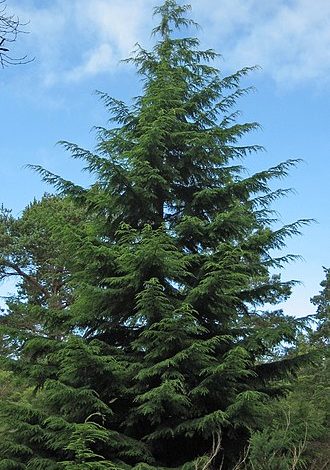Tsuga

Tsuga (/ˈsuːɡə/,[3] from Japanese 栂 (ツガ), the name of Tsuga sieboldii) is a genus of conifers in the subfamily Abietoideae of Pinaceae, the pine family. The common name hemlock is derived from a perceived similarity in the smell of its crushed foliage to that of the unrelated plant poison hemlock. Unlike the latter, Tsuga species are not poisonous.[4]
Eight to ten species are within the genus (depending on the authority), with four species occurring in North America and four to six in eastern Asia.[5][6][7][2][8]
They are medium-sized to large evergreen trees, ranging from 10–60 m (33–197 ft) tall, with a conical to irregular crown, the latter occurring especially in some of the Asian species. The leading shoots generally droop. The bark is scaly and commonly deeply furrowed, with the colour ranging from grey to brown. The branches stem horizontally from the trunk and are usually arranged in flattened sprays that bend downward towards their tips. Short spur shoots, which are present in many gymnosperms, are weakly to moderately developed. The young twigs, as well as the distal portions of stem, are flexible and often pendent. The stems are rough due to pulvini that persist after the leaves fall. The winter buds are ovoid or globose, usually rounded at the apex and not resinous. The leaves are flattened to slightly angular and range from 5–35 mm long and 1–3 mm broad. They are borne singly and are arranged spirally on the stem; the leaf bases are twisted so the leaves lie flat either side of the stem or more rarely radially. Towards the base, the leaves narrow abruptly to a petiole set on a forward-angled pulvinus. The petiole is twisted at the base so it is almost parallel with the stem. The leaf apex is either notched, rounded, or acute. The undersides have two white stomatal bands (in T. mertensiana they are inconspicuous) separated by an elevated midvein. The upper surface of the leaves lack stomata, except in T. mertensiana. They have one resin canal that is present beneath the single vascular bundle.[5][6][7][2][8]
Tsuga mertensiana foliage and cones
The pollen cones grow solitary from lateral buds. They are 3–5(–10) mm long, ovoid, globose, or ellipsoid, and yellowish-white to pale purple, and borne on a short peduncle. The pollen itself has a saccate, ring-like structure at its distal pole, and rarely this structure can be more or less doubly saccate. The seed cones are borne on year-old twigs and are small ovoid-globose or oblong-cylindric, ranging from 15–40 mm long, except in T. mertensiana, where they are cylindrical and longer, 35–80 mm in length; they are solitary, terminal or rarely lateral, pendulous, and are sessile or on a short peduncle up to 4 mm long. Maturation occurs in 5–8 months, and the seeds are shed shortly thereafter; the cones are shed soon after seed release or up to a year or two later. The seed scales are thin, leathery, and persistent. They vary in shape and lack an apophysis and an umbo. The bracts are included and small. The seeds are small, from 2 to 4 mm long, and winged, with the wing being 8 to 12 mm in length. They also contain small adaxial resin vesicles. Seed germination is epigeal; the seedlings have four to six cotyledons.[5][6][7][2][8]
Mountain hemlock, T. mertensiana, is unusual in the genus in several respects. The leaves are less flattened and arranged all round the shoot, and have stomata above as well as below, giving the foliage a glaucous colour; and the cones are the longest in the genus, 35–80 mm long and cylindrical rather than ovoid. Some botanists treat it in a distinct genus as Hesperopeuce mertensiana (Bong.) Rydb.,[9] though it is more generally only considered distinct at the rank of subgenus.[5]
Tsuga canadensis boughs shedding older foliage in autumn
Another species, bristlecone hemlock, first described as Tsuga longibracteata, is now treated in a distinct genus Nothotsuga; it differs from Tsuga in the erect (not pendulous) cones with exserted bracts, and male cones clustered in umbels, in these features more closely allied to the genus Keteleeria.[5][7]
